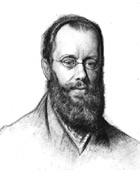Edward Lear was born in Holloway, London. He father was a stockbroker and he was brought up largely by his sister Ann. He spent his early years first as a draughtsman for the Zoological Society, then as an artist for the British Museum.
In 1832 he was employed by the Earl of Derby to make coloured drawings of the rare birds and animals in the menagerie at Knowsley Hall. The Earl also allowed Lear the means to travel widely. He published accounts of his trips to Italy (1846), Albania and Illyria (1851), Calabria (1852), and Corsica (1870). He also visited the Holy Land and Greece.
He is chiefly remembered for his nonsense poetry, the first volume of which was written for his patron's grandchildren in 1846 and was simply entitled A Book of Nonsense. It contained Lear's favourite poetic format, the limerick, and was illustrated throughout. His poetry was henceforth marked by an air of ludicrous fantasy, as well as a unique inventiveness.
A deep sense of sadness can also be traced in his nonsense verse. This melancholy was a reflection of the life of the writer, who, despite the support of friends such as Tennyson's wife Emily, suffered from depression and loneliness.
Since his death, appreciation of his artistic work, the water-colours in particular, has risen. His real fame, however, was secured by poems from Nonsense Songs (1871) such as 'The Owl and the Pussycat'. |






